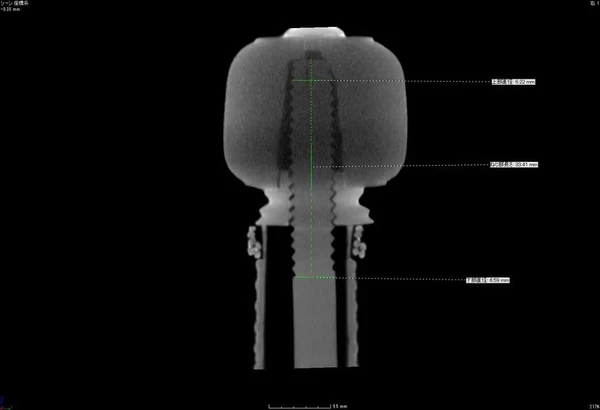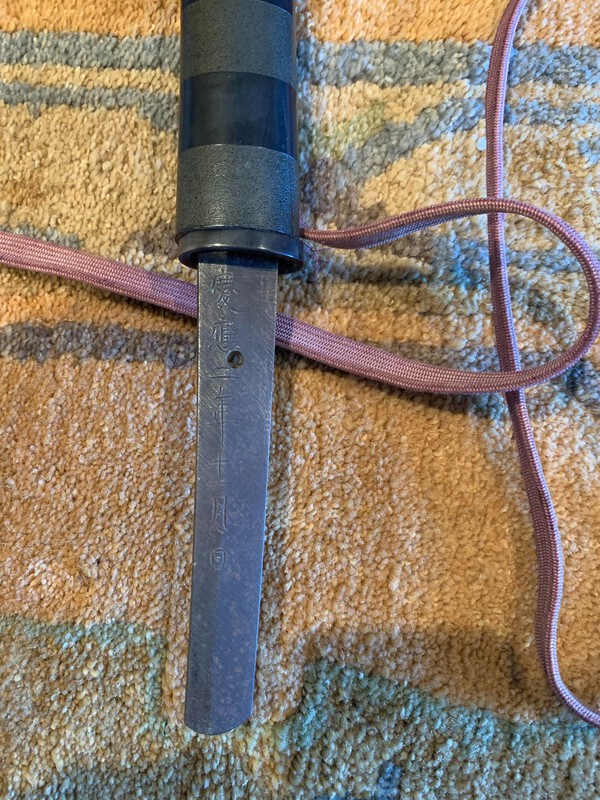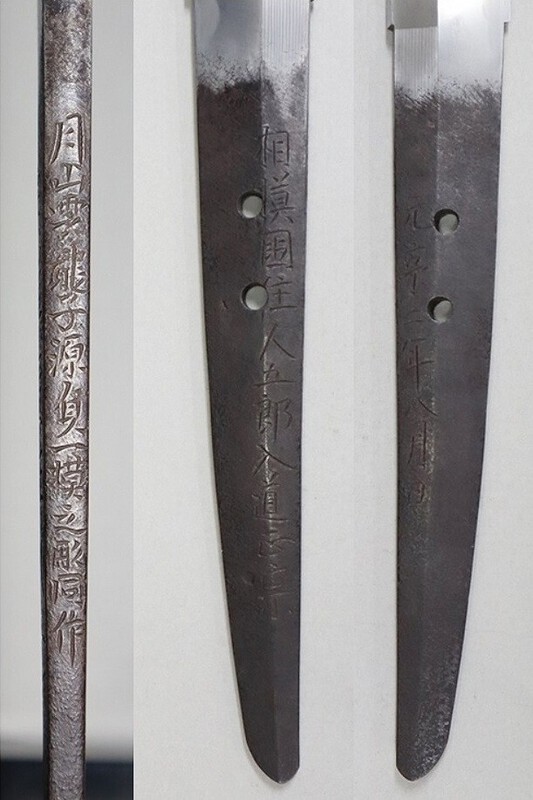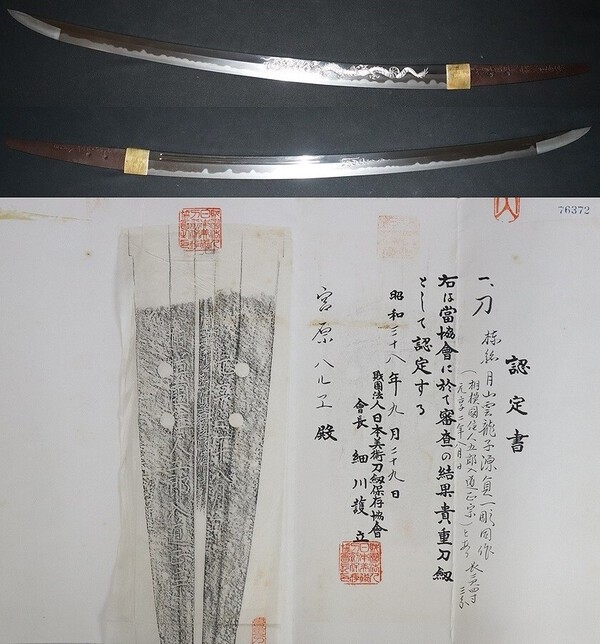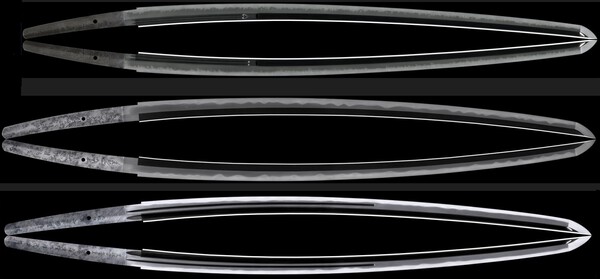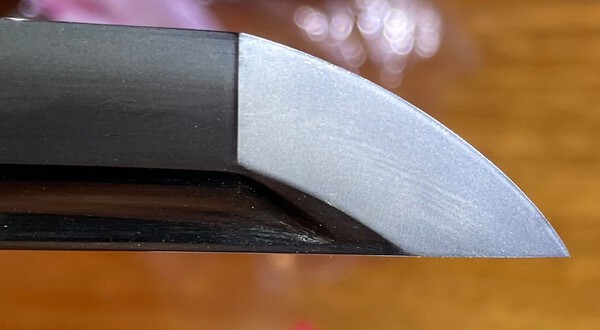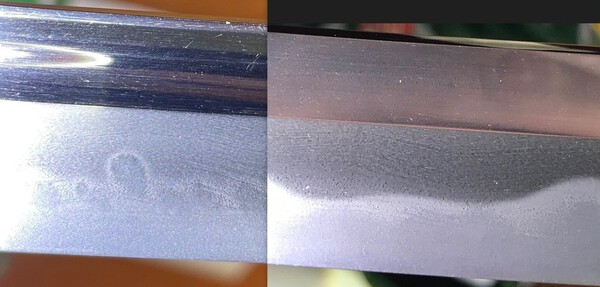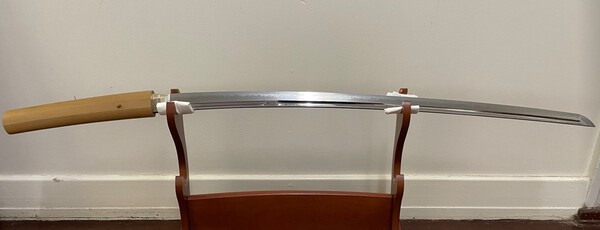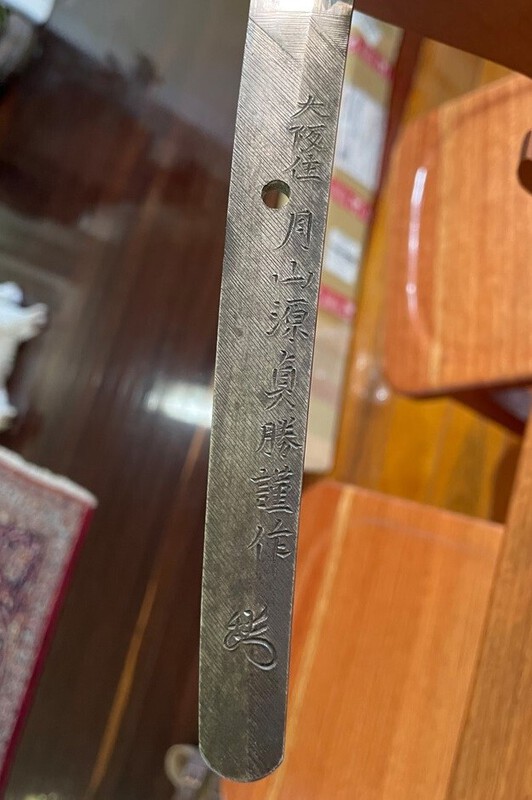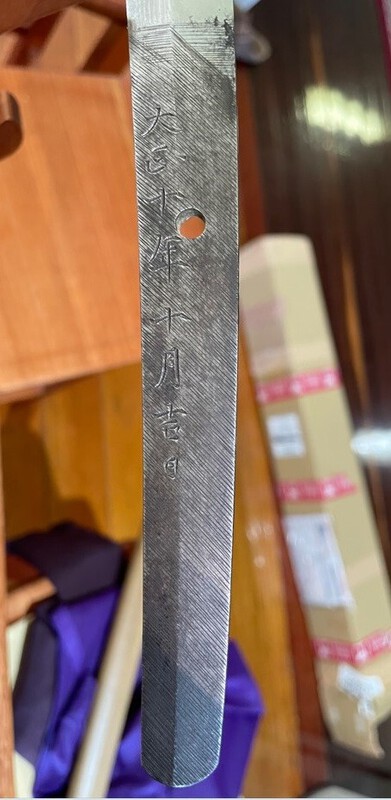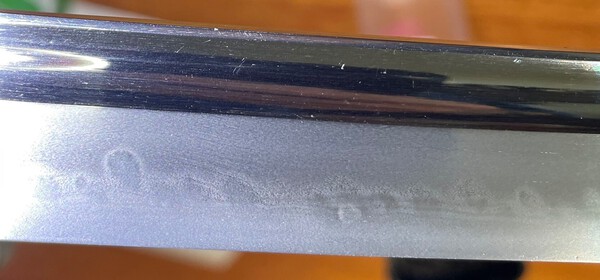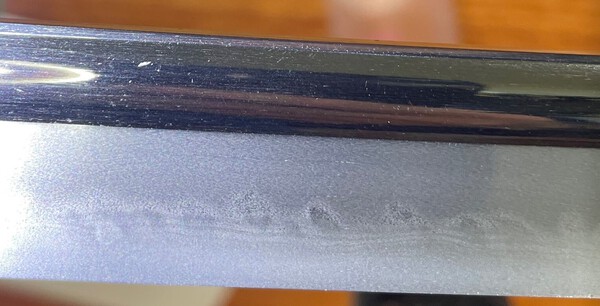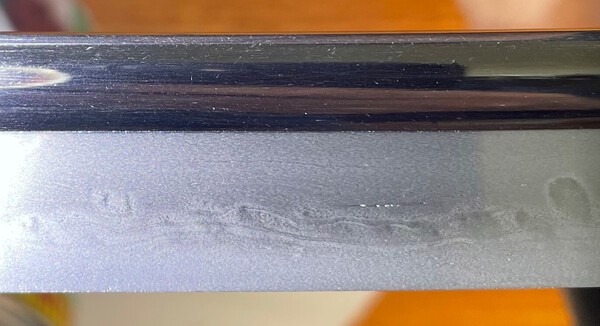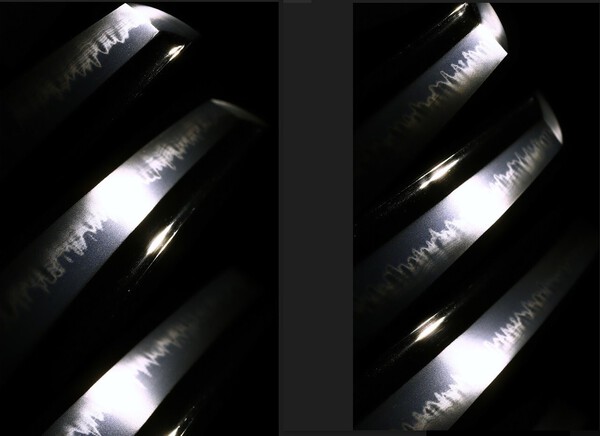-
Posts
691 -
Joined
-
Last visited
-
Days Won
12
Everything posted by Bryce
-
Thanks Jacques, In the absence of more detailed images, my opinion is that the differences you highlighted are all well within the limits of variation I have seen in Sadakatsu's mei. Cheers, Bryce
-
G'day Jacques, What are the characteristic marks that you aren't seeing? Cheers, Bryce
-
G'day Guys, Gassan Sadakatsu was very consistent in the way he signed. He almost always signed "kinsaku", occasionally "saku" only, these are the first blades I have seen not even signed "saku". This is also the first time I have seen him sign as the sendai Gassan Sadakatsu. Also on custom ordered swords he usually writes "Tame" then the person's name. I am not for a minute suggesting these blades are gimei, but am simply trying to determine the significance (if any) of him changing the way he signed for these blades. Cheers, Bryce
-
G'day Guys, The fact that there are at least 3 examples found now suggests to me that we are missing something in the translation. I don't think these were commissioned by an individual, but were made by Sadakatsu to commemorate something? Cheers, Bryce
-
-
Congratulations Noah, It looks 100% right. Even has a Gassan habaki. I would love to see some better photos when you have time. Have a look over at the Gassan School thread as David suggested and see if you can make out what sort of hada it has. Cheers, Bryce
-

Daimyo's Rapier ......Made by Japanese Craftsmen
Bryce replied to a topic in General Nihonto Related Discussion
G'day Guys, Here are the photos in case the link is broken. It looks to have very little distal taper, so not sure how "good" it would feel in hand. I have read several times about mythical blades being able to be coiled up. In this case it is into a small box, in the case of Andrea Ferrara blades from Scotland it is being able to be wrapped around the waist and Damascus steel shamshirs being able to be coiled up in a hat! In all cases it doesn't stand up to logic. To be able to perform a cut or thrust effectively a sword needs to be fairly rigid. If it is flexible enough to coil inside a small box or hat, it isn't going to be much use in a fight. Sword blades aren't very bulky to ship, so I don't see any reason you would want to coil it into a box to send. If it was rigid enough for a thrust, imagine the explosive potential a long blade would have if compressed into that small of a space. As the above article goes on to say, it is an exaggeration. Cheers, Bryce -
G'day Guys, I have to agree with Jean on this one. Compare below a nice, gendaito nakago from the same year as the subject blade. Craig can tell us if we are wrong. Cheers, Bryce
-
G'day Bruce, I think the two kao you posted above are by Gassan Sadakatsu, rather than Sadakazu. The one on the left was late in his career and the one on the right early. Below are the four different kokuin I have seen on Sadakazu blades papered by the NBTHK, with the earliest on the left grading to latest on the right. Some people think that number 3 (going from left to right) is gimei, but the NBTHK do paper these. Cheers, Bryce
-
G'day Andrew, I haven't found any evidence that Sadakazu preferred a certain style of habaki, unlike his son Sadakatsu. Cheers, Bryce
-
G'day Andrew, Here are some shots comparing your blade to papered examples from the same time period. The forger put some effort into copying Sadakazu's mei and kao, but the kokuin and date side is way off. Cheers, Bryce
-
G'day Andrew, Yes these photos are better. What stands out to me? Basically, the way that almost all of the kanji are formed, the kao and the kokuin don't conform with how Sadakazu did it. It is a bit like comparing hand writing. Compare your example with some of the others I posted in the "Works of Gassan Sadakazu" thread. The other part of the story is the work in the blade. Unfortunately I can't see any details of the hada or hamon in the other photos of the blade you posted. You need to be able to see this to decide if the blade does or doesn't look like the work of Sadakazu. Cheers, Bryce
-
G'day Andrew, I am in no way an expert, but I have spent a fair amount of time studying Gassan Sadakazu blades recently. Based on what I can see in your photos, I think your blade is gimei. This means that it is a genuine Japanese blade, but wasn't made by Gassan Sadakazu. Someone has forged the signature of Sadakazu to pass this blade off as Gassan. However, there is a lot of variation in the way Sadakazu signed. Are you able to post some better photos of the blade's nakago (tang) showing the mei, kao and kokuin in crisp detail? Below are the photos you posted showing your blade. Cheers, Bryce
-
G'day Colin, well done! I completely missed your daisho, but I did win the British 1796 sword presented to a survivor of the famous charge of the light brigade, which was a few lots earlier. Cheers, Bryce
-
G'day Thomas, Thanks for posting this. It took me a while to find the time to have a good look at this. Is this a Masamune utsushi forged by Sadakazu? Cheers, Bryce
-
G'day Guys, I don't think it can be anything to do with military regulations. You find a very wide range of blades in military mounts. I guess it probably just comes down to the fashion of the day, but Sadakatsu was certainly welded on to his Showa period sugata. Cheers, Bryce
-
G'day Ray, Fantastic video! Have you (or can you) ever posted any more detailed shots of this blade? Cheers, Bryce
-
G'day Guys, Gassan Sadakatsu was very consistent in the blades he produced, but his style did change over time. Below is a photo showing three blades dated from top to bottom - 1921, 1940 and 1943. (Thank you to AOIJapan for the images.) His earlier blades produced in the Taisho period tend to be slimmer, shorter and straighter than his Showa period examples. Tsurata san has the theory this was because many were used as parade sabres. They usually have a nagasa in the range of 64-68cm, with a sori of 1.4 - 1.7cm and a kissaki around 2.5cm. Many are done in Bizen den. In contrast his Showa period examples usually have a nagasa of 67 - 70cm, sori of 1.8 - 2.2cm and a 3.0cm kissaki. The majority are done in ayasugi and masame. All of the 1943 dated examples I have seen are similar, but have a slightly longer kissaki around 3.5cm. Cheers, Bryce
-
-
G'day Guys, Here is a comparison photo with another Sadakatsu which is definitely very fine masame. 1921 on left and 1940 on right. Cheers, Bryce
-
- 421 replies
-
- 10
-

-

-
G'day David, There are chikei, but I think they are following the underlying masame structure. Cheers, Bryce
-
G'day Guys, You often see it written that Gassan Sadakatsu was a master of the Bizen, Yamato and Soshu traditions as well as the Gassan ayasugi. In his Showa period examples, ayasugi is most common followed by Yamato and Soshu, but I am yet to see a Bizen example. After researching examples of Gassan Sadakazu's work, I noticed that Sadakatsu went thru a Bizen phase in the late Meiji and Taisho periods when he was making Daisaku blades for Sadakazu. Here is an example of Sadakatsu's Bizen work from 1921, three years after his father's death. It looks to be imitating an Ichimonji hamon. The jihada was described as koitame, but I think if you look very closely it is actually very fine masame. Cheers, Bryce
-
G'day Guys, Here is another habaki, which you wouldn't call a classic Gassan habaki, but I believe it was probably made by Gassan Sadakatsu. it is on a Sadakatsu blade dated Taisho 10. It is solid silver gilt, with a bamboo fence motif. Cheers, Bryce



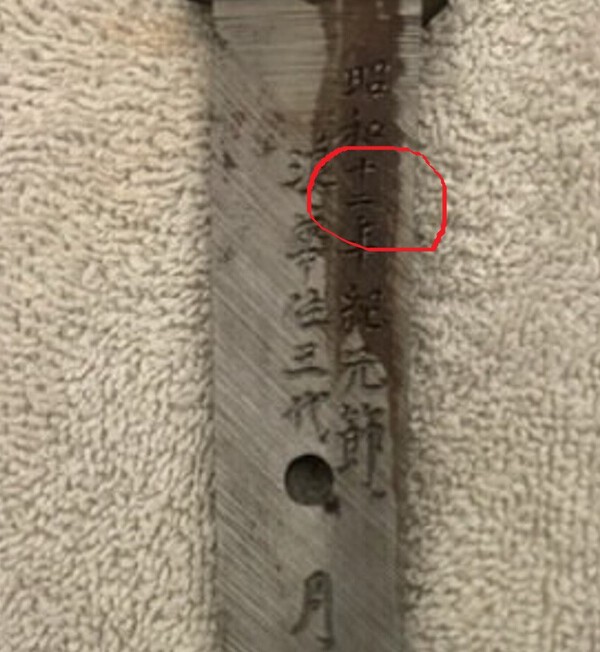
.thumb.jpg.0f4368b248d54e33f3ba0eb190999897.jpg)
